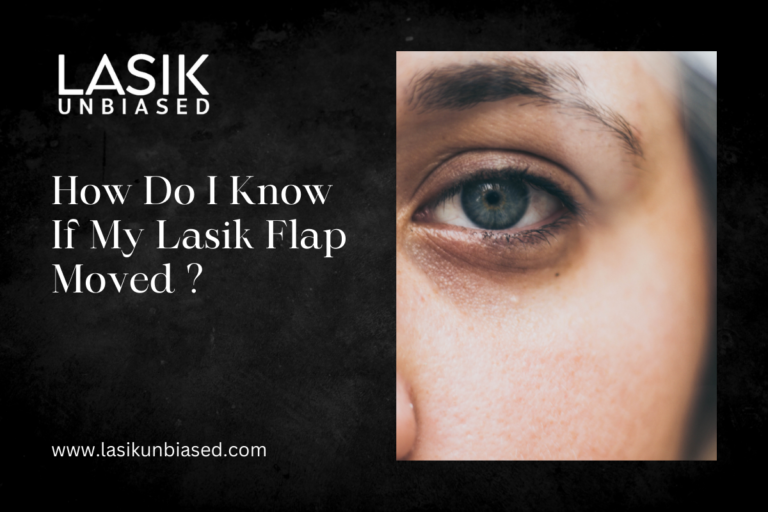Understanding the LASIK Flap
LASIK surgery involves the creation of a thin flap in the cornea, which is lifted to allow the underlying tissue to be reshaped with a laser. After the procedure, the flap is repositioned to heal naturally without stitches. In most cases, the flap heals appropriately within a few days to weeks. However, due to its delicate nature, there are instances where the LASIK flap could shift or move, especially in the early stages of healing. Knowing the signs of a displaced flap can help you address any issues promptly and seek medical attention if necessary.
Symptoms of a Moved LASIK Flap
If your LASIK flap has moved, you may experience various symptoms, ranging from mild discomfort to more severe visual disturbances. Some common signs that could indicate the flap has shifted include:
- Blurred or Distorted Vision: One of the most noticeable symptoms is a sudden change in the quality of your vision. If you experience a reduction in clarity or distorted vision, it might be due to the flap shifting from its original position.
- Eye Pain or Discomfort: While some discomfort is normal after LASIK, sharp or persistent pain can indicate that the flap has moved. The discomfort may feel like something is in your eye, similar to the sensation of having a foreign object lodged in it.
- Double Vision: Double vision can occur if the flap is misaligned, causing the light entering your eye to scatter or bend in different directions. This indicates that your flap may not be in its correct position.
- Flashes of Light or Glares: If you notice halos, starbursts, or flashes of light, particularly at night, this could indicate that the flap is not aligned correctly, affecting your vision.
If you experience any of these symptoms, it’s essential to contact your eye surgeon or healthcare provider immediately.
What Causes the LASIK Flap to Move?
Several factors can cause the LASIK flap to move, particularly in the first few days or weeks following surgery when the flap is still healing. These include:
- Injury or Trauma: Any physical trauma to the eye, such as rubbing your eyes too hard, accidental contact with objects, or even activities like sports, can displace the flap. Even minor pressure on the eye can cause the flap to shift.
- Improper Healing: While most LASIK flaps heal quickly, some individuals may experience delayed or improper healing, especially if they have underlying eye conditions or are at risk of complications.
- Eye Rubbing: Rubbing your eyes, particularly during the initial healing phase, can disrupt the position of the flap. The corneal flap is quite fragile, and even the slightest pressure can lead to displacement.
- Dry Eyes: Dryness in the eyes can slow down the healing process and cause the flap to become less adherent. If your eyes are excessively dry post-surgery, the flap may not stay securely in place.
Understanding these causes can help you take the necessary precautions during your recovery period to avoid complications.
What to Do If You Suspect a Moved LASIK Flap
If you think your LASIK flap has moved, it is essential to take immediate action to ensure your vision is not compromised. The first step is to schedule an emergency visit with your LASIK surgeon or ophthalmologist. During the visit, the doctor will thoroughly examine your eye to assess the condition of the flap. This may include:
- Visual Acuity Test: The surgeon will check your visual clarity to determine if the flap’s movement has affected your sight.
- Slit-Lamp Examination: A slit lamp allows the doctor to examine the cornea and flap in detail. This will help determine if the flap has shifted, folded, or created other issues.
- Fluorescein Dye Test: Sometimes, a special dye may be applied to your eye to assess how the flap is healing and whether it is properly aligned.
If your flap has moved slightly but is still in good condition, the doctor may be able to reposition it with minimal intervention. In more severe cases, the flap may need to be lifted and repositioned under anaesthesia. If the flap has been displaced for longer, the doctor will guide the best course of action to restore optimal vision.
Prevention Tips to Avoid LASIK Flap Movement
To reduce the risk of your LASIK flap moving during recovery, there are several precautions you should take:
- Avoid Rubbing Your Eyes: This is the most crucial rule post-surgery. If your eyes feel itchy or uncomfortable, refrain from rubbing them, as this can displace the flap.
- Follow Post-Surgery Care Instructions: Your doctor will provide specific instructions for eye care after surgery. These instructions include using prescribed eye drops, wearing protective eyewear, and avoiding certain activities.
- Protect Your Eyes: During the healing process, avoid any activities that may put stress on your eyes, such as strenuous exercises or contact sports. Always wear eye protection if necessary.
- Use Artificial Tears: If you experience dry eyes, use the prescribed artificial tears to keep your eyes moist and aid in healing. Dryness can cause the flap to adhere improperly.
- Sleep with Eye Shields: During the initial recovery phase, most LASIK patients are advised to wear protective eye shields while sleeping to prevent accidental rubbing.
By following these guidelines, you can minimize the risk of complications and ensure the healing process goes smoothly.
Can a Moved LASIK Flap Cause Long-Term Damage?
In most cases, if a LASIK flap has shifted, it does not lead to permanent damage as long as it is treated promptly. The corneal tissue is highly resilient and can heal well after repositioning the flap. However, if the flap is left in a displaced position for too long or if there is significant trauma to the eye, there may be long-term effects such as:
- Scarring: If the flap is not realigned correctly, scar tissue may form, affecting visual clarity.
- Infections: An improperly healed flap may increase the risk of infection, further complicating the healing process and causing permanent damage to the cornea.
- Permanent Vision Disturbances: In rare cases, a displaced flap can lead to chronic visual disturbances, such as glare or reduced visual acuity.
However, with prompt medical attention and appropriate intervention, these long-term complications are rare. Most patients who experience a displaced flap can recover fully and regain stable vision.


